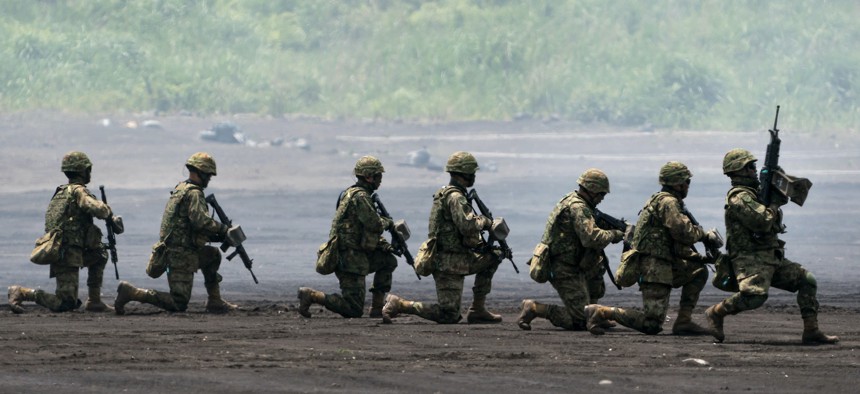
Members of the Japan Ground Self-Defense Force (JGSDF) take part in a live fire exercise at East Fuji Maneuver Area on May 27, 2023 in Gotemba, Shizuoka, Japan. Getty Images / Tomohiro Ohsumi
Defense Business Brief: Anduril eyes Japanese defense market; ‘Angry Kitten’ tested during combat exercises; F-14 Tomcat needs a flat fixed; and more.
Anduril has signed agreements with three Japanese trading companies, a move the U.S. security startup says will give it access to Tokyo’s expanding defense market.
The company billed the agreements as “a significant milestone in its expansion” into the Asia-Pacific region.
“These new partnerships represent the beginning of an exciting collaboration that will provide innumerable benefits for Japan, and Indo-Pacific security, more broadly,” the company said in an emailed statement.
The agreements with Sumitomo Aero-Systems Corporation, Itochu, and another undisclosed trading company were announced late Tuesday in the United Stated—Wednesday morning in Japan.
In addition to its Lattice OS software, which the company touts as a way to bring autonomy to military missions, Anduril is an emerging player in the drone, counter-drone, and undersea vehicle markets.
The agreements come as Japan, which last year modified its constitution to allow it to strike enemy targets, broadens its security strategy beyond just self defense, and the United States and its allies in Asia, take steps to counter China’s military build up.
“As Japan is finding itself in the midst of the most severe and complex security environment since the end of WWII, maintaining and developing a free and open international order based on the rule of law are becoming as important as it has ever been,” Japan’s National Security Strategy reads.
Japanese defense spending for 2023 is about $49.4 billion, a 24 percent increase over 2022, and is expected to rise even more in the coming years, according to data from Forecast International, a consulting firm owned by Defense One parent company GovExec. And spending levels are projected to further increase because Japanese leaders have signaled a desire to spend 2 percent GDP on defense—the benchmark, but unenforced, level desired by NATO alliance members.
To achieve that goal, Tokyo’s defense spending would have to grow to between $70 billion and $75 billion (in 2022 dollars), according to Forecast International. That’s an average of $63 billion per year between 2023 and 2027.
Welcome
You’ve reached the Defense Business Brief by Marcus Weisgerber. Send along your tips, and feedback to mweisgerber@defenseone.com or @MarcusReports. Check out the Defense Business Brief archive here, and tell your friends to subscribe!
The White House and House Republicans agreed to a budget agreement over the Memorial Day weekend that would fund defense in fiscal 2024 at the $842 billion proposed by Biden administration earlier this year. The bill would raise the so-called debt ceiling for two years and prevent the U.S. from defaulting on its loans. Congress must pass the deal by June 5.
CNA’s Jeffrey Edmonds and Samuel Bendett dropped a new report Tuesday on Russia’s use of drones in Ukraine. Researchers found Moscow has had trouble getting data from reconnaissance drones fast enough to strike mobile targets.
“The lag in detection and targeting time highlights the lack of military-grade uncrewed combat aerial vehicles (UCAVs) in Russia’s arsenal,” the report states. “These systems would enable a faster detection-to-kill time. While the Russian military is clearly investing in these systems as evidenced by military announcements before the war, they are not likely to appear on the battlefield anytime soon.”
The report also found that the “Russian military industrial complex has been slow to produce them in the significant numbers required by Russian forces. Some of the lack of production likely comes from a lack of domestic capabilities, inter-organizational competition and lack of communication, and a lack of central Russian government leadership on this issue.”
Read the entire report here.
The U.S. Air Force tested the terrifyingly named “Angry Kitten” electronic jamming pod during its massive Northern Edge combat exercise in Alaska this month. The ALQ-167 pod “was tested for its effectiveness jamming simulated enemy systems,” according to the Air National Guard Air Force Reserve Command Test Center. “Housed in removable, adaptable pods under aircraft wings or fuselages, it uses machine learning to disrupt adversarial [electronic warfare] capabilities,” the Air Force said.
What’s key about the tests is that the pod was used on non-stealthy F-16 fighters and A-10 attack jets. The Air Force recently tested the pod on MQ-9 Reaper drones. “The pod provides the MQ-9 elevated Electronic Attack (EA) capability against relevant ground and airborne threats,” the Air Force said. “This capability enhances survivability for the Reaper and other friendly forces, and complicates adversary planning efforts.”
The Air Force said it did the MQ-9 tests to find ways of using the drones against “pacing challenge” threats, aka those posed by countries like China and Russia.
Stratolaunch plans to acquire the rocket-launching 747 aircraft owned by the now-defunct Virgin Orbit, allowing the company to increase hypersonic flight testing. “Upon closing of the acquisition, the additional aircraft will be repurposed as a launch platform for Stratolaunch's Talon-A reusable hypersonic testbeds and is expected to be fully operational in 2024,” Stratolaunch said. “The expansion of Stratolaunch's fleet will increase its in-flight test capacity and ability to support government and commercial customers globally.”
The Cradle of Aviation Museum on Long Island is in need of an F-14 maintainer to change a flat tire on a Tomcat set to go on display in August. The jet, which last flew aboard the USS Theodore Roosevelt, is in the process of being restored after spending recent years in front of what’s left of Northrop Grumman’s Bethpage, N.Y. facilities, Newsday reports. The museum has a spare tire, but doesn’t know the proper maintenance procedure to change it. You can contact the museum here.
Making Moves
Defense Secretary Lloyd Austin appointed Asia Group President Rexon Ryu to the Defense Policy Board.


